

Comprehensive CBT for Social Anxiety. You cannot tell a person with social anxiety to simply stop thinking negative thoughts.

Obviously, the person does not want to think negatively, and if they could choose to stop thinking negatively, they would do so in a heartbeat. Specific Solutions to Anxiety Symptoms Must Be Taught and Learned We must employ very specific ways to allow the person to begin to (a) catch their own automatic negative thinking, (b) find distractions to use while therapy is in progress, and (c) begin to turn the tables on automatic negative thinking gradually. The mind will not accept "irrational positive" statements or beliefs. Repeating "I will wake up in the morning and be happy, content, and less anxious" will do absolutely nothing, because this statement is irrational, given the current state of the mind. The mind cannot work overnight and cannot be pressured into learning things faster. Now, to get even more specific, how do we accomplish these cognitive goals? (c) anger arising from past situations,
Ways to Reset Your HPA Axis & Dramatically Improve Emotional Health. Our body is a system in which all of the components are designed to work smoothly and in perfect balance with each other.

The same way that one broken part can bring a car to a screeching halt, so can our bodily organs. The last article was a short introduction to our HPA Axis. Traditionally viewed as the body’s “stress system”, it controls levels of cortisol and other important stress related hormones. But often, it too can brake.
Like a leaky Fukushima reactor, a disfunctional HPA Axis can slowly intoxicate our system for a period of time, stressing the entire body and mind. If you haven’t read Part 1: What You Need to Know About Your HPA Axis in Order to Manage Irritability More Effectively, go ahead and read it first, things will make better sense. Brain on stress: How the social environment gets under the skin. Disruption of Maternal Parenting Circuitry by Addictive Process: Rewiring of Reward and Stress Systems.
The link between childhood trauma and depression: Insights from HPA axis studies in humans - Psychoneuroendocrinology. To view the full text, please login as a subscribed user or purchase a subscription.
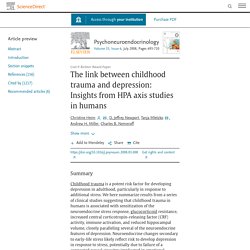
Click here to view the full text on ScienceDirect. Figure 1 Mean (SE) plasma ACTH (A), plasma cortisol (B), and heart rate responses to psychosocial stress induction in adult women with no history of childhood abuse and no psychiatric disorder (controls), women with a history of childhood sexual and/or physical abuse and no current major depression (ELS/non-MDD), women with a history of childhood sexual and/or physical abuse and current major depression (ELS/MDD), and women with current major depression but no history of significant childhood stress. Reprinted from Heim et al. (2000b) . Figure 2. Treatment for Abused and Neglected Children: Infancy to Age 18 - Child Welfare Information Gateway.
Interventions for Children Exposed to Domestic Violence: Core Principles. Safety FirstThe first and most important intervention for children is to address the issues of safety for the family.

This usually involves working with the victim of violence to discuss the options she/he might consider to increase safety. Legal advocacy, shelters, and domestic violence service agencies are good resources for addressing the challenges of safety. How The Effects Of Trauma Can Be Passed Down From One Generation To The Next. Experiencing trauma early in childhood can lead to mental health problems in adolescence and adulthood, but mild to moderate trauma could also have an unexpected upside for some survivors, making them better able to cope with stressful situations later in life.
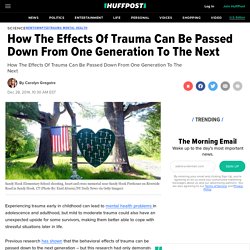
Previous research has shown that the behavioral effects of trauma can be passed down to the next generation -- but this research had only demonstrated that this transmission takes place with trauma's negative effects, such as depression. Now a study on mice, recently published in the journal Nature Communications, suggests that the adaptive benefits of trauma might also stay alive in families through the years. The University of Zurich researchers identified the molecular mechanisms by which the effects of trauma are transmitted from one generation to another. In some cases, the silver lining of a traumatic episode -- that is, learning to better cope with stress -- can also be passed down. The neurobiological toll of child abuse and neglect. Epigenetic programming of the HPA axis: early life decides. Analysis of the Validity Scales in the Trauma Symptom Checklist for Children. Chapter 1 Substance Abuse Treatment and Family Therapy - Substance Abuse Treatment and Family Therapy - NCBI Bookshelf.
Childhood Maltreatment Can Leave Scars In The Brain. Hide captionGirls are particularly vulnerable to brain changes caused by stress or trauma, researchers say.
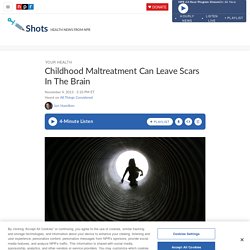
Allen Johnson/iStockphoto.com Maltreatment during childhood can lead to long-term changes in brain circuits that process fear, researchers say. This could help explain why children who suffer abuse are much more likely than others to develop problems like anxiety and depression later on. Psyneuen-journal. Mapping Poverty in America. Study: Most Child Abuse Goes Unreported. Children in highly developed countries suffer abuse and neglect much more often than is reported by official child-protective agencies, according to the findings of the first in a comprehensive series of reports on child maltreatment, published Dec. 2 in the British medical journal The Lancet.

Based on a review of research conducted on child abuse between 2000 and June of this year, researchers estimate that 4% to 16% of children are physically abused each year in high-income nations, including the United States, United Kingdom, Australia and Canada. As many as 15% are neglected, and up to 10% of girls and 5% of boys suffer severe sexual abuse; many more are victims of other sexual injury. Yet researchers say that as few as 1 in 10 of those instances of abuse are actually confirmed by social-service agencies — and that measuring the exact scope of the problem is nearly impossible.
(See the Year in Health, from A to Z.) Those numbers, researchers say, may now be on the rise. Child abuse statistics – Get the facts of Child abuse and neglect. How Are We Really Doing?
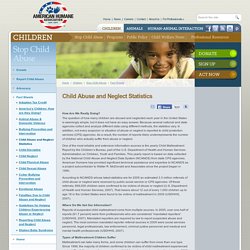
The question of how many children are abused and neglected each year in the United States is seemingly simple, but it does not have an easy answer. Because several national and state agencies collect and analyze different data using different methods, the statistics vary. In a Year, Child-Protective Services Checked Up on 3.2 Million Children — The Atlantic. The stories of Debra Harrell, the working mother who was arrested for letting her 9-year-old spend summer days alone at a park crowded with families; the widow who left four kids home alone for a few hours, only to have them taken by the state; and Kim Brooks, whose nightmare began when she left her kid in the car while running a quick errand, have all sparked sympathetic, insightful commentary at a number of national publications, along with lots of reader email.
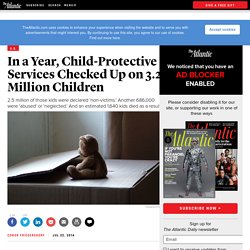
A number of correspondents granted that the families in these anecdotes were subject to overzealous responses, but guessed that their experiences are anomalous. Others felt that the larger problem is the state failing to remove children from legitimately dangerous situations that lead to grave injuries or even death. Every year, the Department of Health and Human Services published statistics on the work of child protective service agencies in all 50 states, Washington, D.C. and Puerto Rico.
The Effect of Family Income on Risk of Child Maltreatment. Myths/Facts Sex Offenders (CSOM) Myths and Facts About Sex OffendersAugust 2000 There are many misconceptions about sexual offenses, sexual offense victims, and sex offenders in our society.
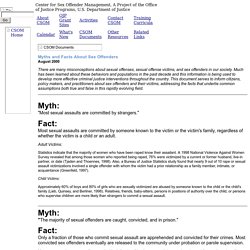
Much has been learned about these behaviors and populations in the past decade and this information is being used to develop more effective criminal justice interventions throughout the country. This document serves to inform citizens, policy makers, and practitioners about sex offenders and their victims, addressing the facts that underlie common assumptions both true and false in this rapidly evolving field. Myth:"Most sexual assaults are committed by strangers. " Fact:Most sexual assaults are committed by someone known to the victim or the victim's family, regardless of whether the victim is a child or an adult. Adult Victims: Statistics indicate that the majority of women who have been raped know their assailant. CVVOATV.PDF. Dp138510.pdf. Child abuse statistics – Get the facts of Child abuse and neglect. Child_Trends-2013_01_01_AHH_MHAccessl.pdf. The long-term treatment of victims of child abuse.
Child Abuse Statistics. Study: Most Child Abuse Goes Unreported.